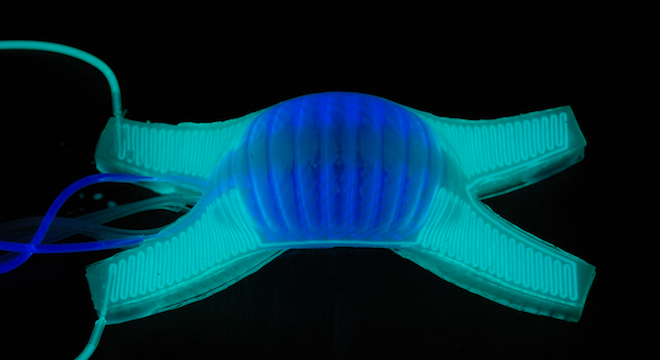Robots don’t have to be expensive, boxy, blocky, jerky hunks of metal.
In fact, the robots of the near future will be cheap, soft-bodied and octopus-like, capable of changing colors to blend in with their surroundings, at least if the Pentagon and Harvard University scientists have anything to do with it.
Prototypes of such soft-bodied, camouflaging robots have been successfully demonstrated and tested on different types of terrain, according to the Defense Advanced Research Projects Agency (DARPA), the Pentagon arm responsible for many of the military’s most far-flung scientific endeavors (including, back in the 1960s, the prototype of the Internet itself.)
DARPA on Thursday published a video of one such robot, which can be seen below:
“Soft robot design is certainly inspired by nature,” said Stephen Morin, one of the lead Harvard researchers behind ‘bot, in an email to TPM. “Specifically, creatures like starfish, squid, and octopi. There is no reason why robots should only adopt the familiar shapes of mammals, as many hard robots do. Other designs will certainly have advantages; like a tentacle over an arm. That said, we also believe in building robots that don’t follow body plans found in nature. We don’t want to limit ourselves.”
This particular prototype is just one of over 75 different soft-bodied models built at Harvard’s Department of Chemistry and Chemical Biology and the Wyss Institute for Biologically Inspired Engineering, Morin said. Famed Harvard researcher George Whitesides is spearheading the work, which was first publicized in November 2011.
The fleet was designed for DARPA’s own Maximum Mobility and Manipulation (M3) program, which seeks to increase the capabilities and maneuverability of robots while simultaneously lowering the costs of production, no easy feat.
But Whitesides and Morin seem to have done just that: The cost of the robot demonstrated in the video is “well under ten dollars,” Morin told TPM. “If produced in volume, this number would be much smaller.”
The low cost, high flexibility and incredible camouflaging capabilities are achieved through the robot’s construction materials and design: It’s made of a silicone substance and has narrow channels throughout, which can be flooded with different types of fluids, which not only help control the robot’s movements — inflating and deflating selected portions of it — but also can alter its color, contrast and temperature, according to DARPA and Harvard.
Right now, the robots are attached to cords or “veins” of liquid, but eventually, researchers hope to make them self-contained.
Though the particular robot shown in the demo video is quite slow — moving at a rate of 130 feet per hour when filled with camouflage fluid, and about 220 feet per hour without the color layer.
“The color layer adds a bit more mass to the robot, and it slightly increase the thickness of the material the actuators need to stretch for movement,” Morin told TPM. “Further engineering of the locomotive platform will eliminate this problem.”
But some of the other robots that Morin and his colleagues have developed have other capabilities as well.
“This particular robot was not designed to grip objects, but we have ones that are,” Morin told TPM. “They are capable of lifting vegetables with masses in the kg range [2.2 pounds]. We also have grippers that can handle delicate objects like uncooked eggs or living mice.”
As far as the utility of such robots, Morin believes that a potential use could be helping to train doctors.
“Devices could be made to look, feel, and ‘act’ like organs,” Morin explained. “If a practicing surgeon cut into the wrong place the device would ‘bleed.'”
But these types of robot could also help solve more basic, longstanding scientific problems, such as those of evolutionary form and function. As Morin put it:
More fundamentally, one of the most interesting questions in science is ‘Why do animals have the shape, and color, and capabilities that they do?’ Evolution might lead to a particular form, but why? One function of our work on robotics is to give us, and others interested in this kind of question, systems that we can use to test ideas.
And while the Harvard researchers have achieved some incredible breakthroughs, its worth pointing out that their program is still in its early days: Their work has been going on for about two years, “so we ar relatively young,” Morin told TPM.






